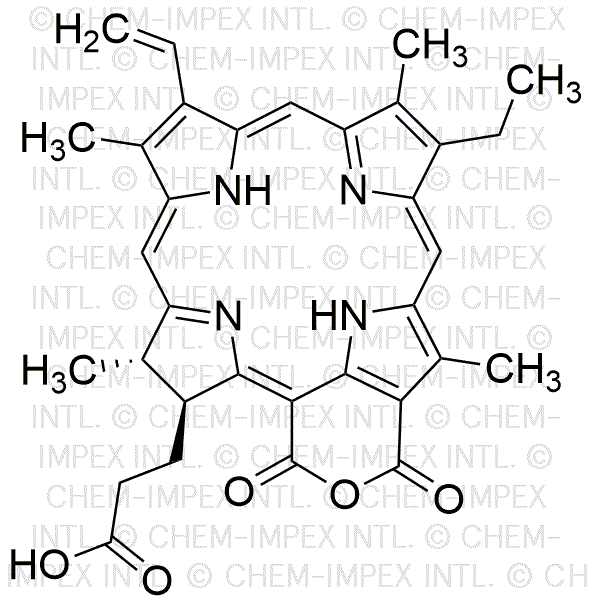Purpurin 18 is widely utilized in research focused on:
- Dyes and Pigments: This compound is often used in the textile industry for its vibrant color properties, providing a sustainable alternative to synthetic dyes.
- Biological Staining: In biological research, Purpurin 18 serves as a fluorescent stain, helping scientists visualize cellular structures under a microscope.
- Photodynamic Therapy: Its ability to absorb light makes it suitable for use in photodynamic therapy, a treatment for certain cancers where light activates the compound to destroy cancer cells.
- Environmental Monitoring: The compound is employed in environmental science to track pollutants, as it can bind to heavy metals and help in assessing contamination levels in water sources.
- Organic Electronics: Purpurin 18 is explored in the development of organic electronic devices, such as organic solar cells, due to its semiconducting properties.
General Information
Properties
Safety and Regulations
Applications
Purpurin 18 is widely utilized in research focused on:
- Dyes and Pigments: This compound is often used in the textile industry for its vibrant color properties, providing a sustainable alternative to synthetic dyes.
- Biological Staining: In biological research, Purpurin 18 serves as a fluorescent stain, helping scientists visualize cellular structures under a microscope.
- Photodynamic Therapy: Its ability to absorb light makes it suitable for use in photodynamic therapy, a treatment for certain cancers where light activates the compound to destroy cancer cells.
- Environmental Monitoring: The compound is employed in environmental science to track pollutants, as it can bind to heavy metals and help in assessing contamination levels in water sources.
- Organic Electronics: Purpurin 18 is explored in the development of organic electronic devices, such as organic solar cells, due to its semiconducting properties.
Documents
Safety Data Sheets (SDS)
The SDS provides comprehensive safety information on handling, storage, and disposal of the product.
Product Specification (PS)
The PS provides a comprehensive breakdown of the product’s properties, including chemical composition, physical state, purity, and storage requirements. It also details acceptable quality ranges and the product's intended applications.
Certificates of Analysis (COA)
Search for Certificates of Analysis (COA) by entering the products Lot Number. Lot and Batch Numbers can be found on a product’s label following the words ‘Lot’ or ‘Batch’.
Numéro de catalogue
Numéro de lot/série
Certificates Of Origin (COO)
This COO confirms the country where the product was manufactured, and also details the materials and components used in it and whether it is derived from natural, synthetic, or other specific sources. This certificate may be required for customs, trade, and regulatory compliance.
Numéro de catalogue
Numéro de lot/série
Safety Data Sheets (SDS)
The SDS provides comprehensive safety information on handling, storage, and disposal of the product.
DownloadProduct Specification (PS)
The PS provides a comprehensive breakdown of the product’s properties, including chemical composition, physical state, purity, and storage requirements. It also details acceptable quality ranges and the product's intended applications.
DownloadCertificates of Analysis (COA)
Search for Certificates of Analysis (COA) by entering the products Lot Number. Lot and Batch Numbers can be found on a product’s label following the words ‘Lot’ or ‘Batch’.
Numéro de catalogue
Numéro de lot/série
Certificates Of Origin (COO)
This COO confirms the country where the product was manufactured, and also details the materials and components used in it and whether it is derived from natural, synthetic, or other specific sources. This certificate may be required for customs, trade, and regulatory compliance.


